REMEMBERING K. RAJAH
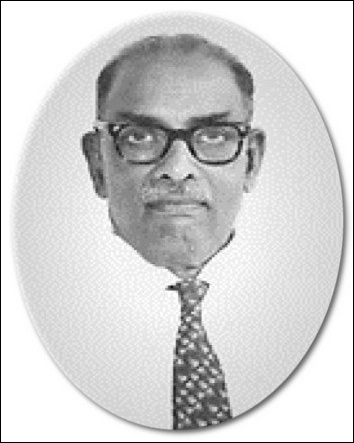
Rajah Kathiravelu
12 May 1898 to 20 December 1992
Profiled here is the story of Mr. Rajah Kathiravelu who demonstrated that age is no barrier when it comes to serving the Faith with youthful energy and zeal. Rajah had served in several capacities, belying his age, and has left traces that remain forever. Presented in this write up are selected anecdotes from his life, that characterized the unique roles he played during the very early days of the establishment of the Faith in Malaysia. K. Rajah as he was called shall forever be remembered as a truly legendary figure in the annals of our Faith.
Rajah worked as a State Treasurer with the Negeri Sembilan state government, holding the responsibility of managing funds and the budget of the state. As State Treasurer, he was highly respected as an honest and hardworking civil servant, whose mature guidance and insightful suggestions brought in much revenue to the state.
Rajah retired at the age of fifty-five in 1953. He was a longtime friend of Yankee Leong, who was the first enlightened soul to accept the Faith in Peninsula Malaya. As soon as Yankee Leong accepted the Faith on 19 December 1953, he took the Faith first to his closest friends in his hometown of Seremban, and that included Rajah. As soon as the Redeeming Message of Bahá’u’lláh was given to him, Rajah investigated the Faith seriously and spent time going into the roots of the teachings, especially the literature that Yankee Leong had given him. In the early days of investigating, Rajah, himself well-grounded in Hinduism would come with huge books on Hinduism and preach to Yankee Leong, who would listen patiently. After Rajah had spoken, it was the turn of Yankee Leong to speak on the Bahá’í Faith. In subsequent visits, Rajah came without the books on Hinduism, highly enthusiastic to listen to Yankee Leong. Soon Rajah was very convinced on the Mission and Message of Bahá’u’lláh. He then accepted the Faith with clarity of thought and as a convinced believer in 1954 at the age of fifty-six, just one year after his retirement.
The acceptance of the Faith by Rajah was not smooth sailing for someone who had risen so high in his career. Rough roads were awaiting from various quarters. Strong opposition came first in his own family, and then from the well-established Ceylonese community in the town of Seremban and from other towns in Malaya. The Ceylonese Tamil speaking community in Seremban had a very large presence, and Rajah grew up as one who was steeply rooted in the cultures and traditions of the Ceylonese Tamil community. It took nothing less than great courage and audacity for him to step out of that circle. Rajah was unshakable as a mountain in his faith in his new-found religion. To Rajah, the Faith seemed to have brought the longed-for light of eternal salvation into his life. His faith translated into formidable actions as he grew in the Faith. The fervor with which he moved and served the Cause at old age until ill health forced him to slow down in the late 1970s was itself remarkable.
Having accepted the Faith in 1954, Rajah was elected on the first Local Spiritual Assembly of Seremban in Ridván 1954, with Yankee Leong as Chairman and Rajah as Vice-Chairman. That was also the first Local Spiritual Assembly of Peninsula Malaya. Rajah would continue to serve on that institution for more than a decade. But the early years came as a great challenge to him. As soon as Yankee Leong accepted the Faith he began traveling to other places in Peninsula Malaya to teach the Cause to his other close friends. In his absence from Seremban town, it was left to Rajah to play the pivotal role of a fatherly figure in building up this community nascent community. Soon he was joined by Mr. Poh Eng Siew, a believer of financial means who worked closely with Rajah in promoting the Cause.
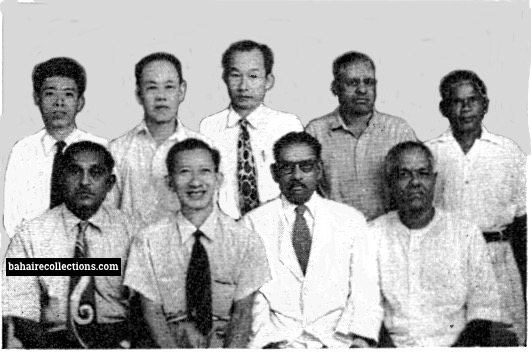
Second Local Spiritual Assembly of Seremban, 1955. Seated in the center are Yankee Leong (L) and K. Rajah (R). Standing at the extreme left is Johnnie Lee, son in law of Yankee Leong.
While Yankee Leong was creating waves outside Seremban, Rajah was equally doing his part in promoting the Cause in Seremban. As soon as he accepted the Faith he immediately took the Faith to all the organizations in which he held prominent positions. His involvement prior to accepting the Cause of Bahá’u’lláh was, among others, in the following organizations:
- Theosophical Society – Chairman
- Negeri Sembilan Government Servants’ Cooperative Society – Chairman
- Vivekananda Society – Vice-Chairman
- Consumer Society of Malaya – Director
- Jaffna Cooperative Society – Member
- Social Welfare Society of Malaya – Treasurer
- Young Men’s Hindu Association of Kuala Pilah – Founder
After taking the Faith to all these organizations, Rajah resigned from all these bodies to be fully committed to the Bahá’í Cause. It was a great surprise to the members of these well-established and prominent organizations that Rajah was giving up membership in his prestigious roles. They expected Rajah to continue leading and guiding them. However, as he had related to close friends, Rajah felt he did not have much time to spare as he had accepted the Faith rather late in his life and this sense of urgency propelled him to want to serve the Faith without any distractions.
Rajah was hungry for knowledge on the Faith. One of the main sources was visitors from abroad and Bahá’í gatherings held in the early days. Dr. Raḥmatu’lláh Muhájir had a great influence on him, starting with the first Bahá’í Summer School in December 1957 where Dr. Muhájir was present. There he had met several other strong pillars such as Dr. K. M. Fozdar, Shirin Fozdar, G. Saurajen, Lena Saurajen, Nong Chik, Mirinal Kanti Paul, Yankee Leong, Chin Chia Kwei, Leong Tat Chee, and Wong Kok Mee, who were among the cream in the Cause. Also present were Jeanne Frankel and her mother Mrs. Margaret Bates who just returned from their pioneering post in the Nicobar Islands. As soon as the Summer School classes came to a close at 10:30 pm on 29 December 1957, Dr. Muhájir convened a meeting that lasted until 12:30 am the following day to discuss on achieving the goals of the plan of the Regional Spiritual Assembly for Malaya. At this gathering, Rajah saw the importance to serve the needs of the Cause and stepped up his activities in Seremban.
The one other very moving period in his life was the Inter-Continental Conference held in Singapore from 27- 29 September 1958 where Rajah met the following Hands of the Cause of God: Leroy C. Ioas, Taráz’u’lláh Samandarí, Abu’l-Qásim Faizi, Harold Collis Featherstone, Dr. Raḥmatu’lláh Muhájir, Miss Agnes Alexander, Shu’á’u’lláh ‘Alá’í, Dr.`Alí-Muhammad Varqá and Enoch Olinga. Rajah as one of the participants gained so much knowledge and inspiration and returned with great enthusiasm and determination to offer his services for the Cause.
Rajah had a great knowledge of the Faith and contacted whoever had information on specific topics. Rajah contacted S. L. Thevar for details on Biblical prophecies and Thevar wrote a long reply dated 15 June 1960 to Rajah, in which he had quoted amply from the Bible on the proof of the fulfillment of the Biblical prophecies in the Bahá’í Faith.
Rajah was also one of the participants in the First Bahá’í World Congress held in London from 28 April to 2 May 1963 where he witnessed the gathering of some 6,000 believers from around the world. He met some Hands of the Cause and members of the first Universal House of Justice. Of the Congress, Rajah commented, “It was a unique gathering… a miracle without parallel.”
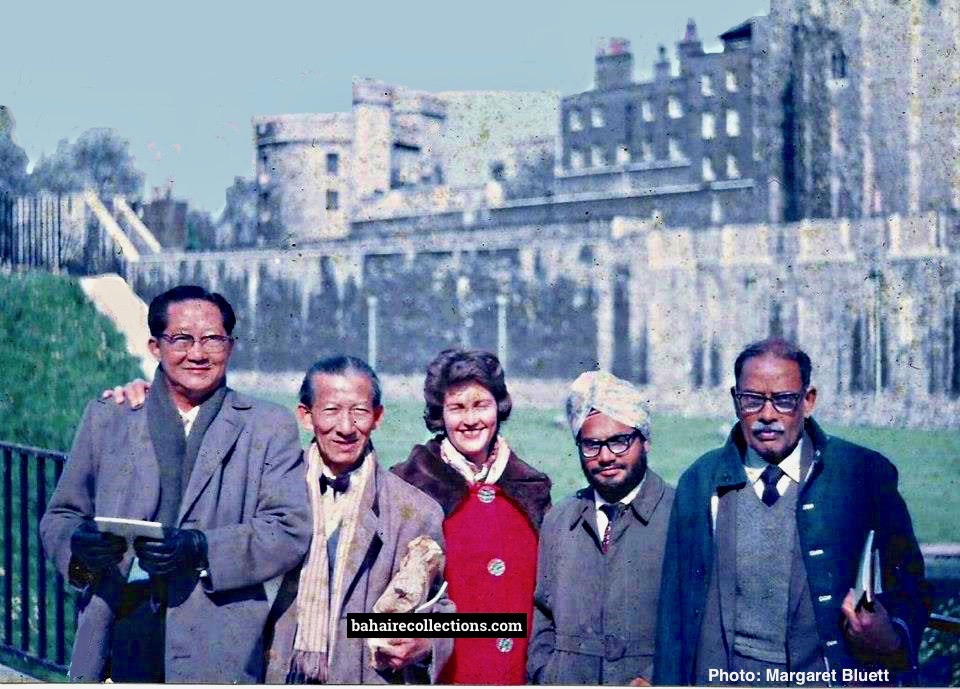
In London, while participating in the First Bahá’í World Congress, 1963. From L-R: Leong Tat Chee, Yankee Leong, Margaret Bluett, Sathiawan Singh, and K. Rajah.
The unshakable faith he had developed came to the fore as early as 1960. While speaking on the topic of The Bahá’í Faith at the Bahá’í Summer School held in Port Dickson in August 1960, Rajah diverted, and suddenly stirred the crowd by reading out a letter dated 18 April 1960 that he wrote to the Theosophical Society of Seremban of which he was once its President. In the letter, he laid ten clear points as to why the Bahá’í Faith provided him more than sufficient grounds for him to resign from that Society. Among the 60 participants who heard Rajah read the letter were Hand of the Cause of God Dr. Muhájir and his wife Mrs. Írán Muhájir; Dr. Eshraghian, Kishen Khemani Mrs. George Lee and Shirin Fozdar from Singapore; Mr. K. Payman from Indonesia, Mr. Utai Tawinwong from Thailand, Mr. Jamshed Fozdar from Saigon, Mrs. Shantha Sundram from Penang, Theresa Chee from Alor Star, Yankee Leong, A. Sabapathy and S. Satanam from Seremban; Leong Tat Chee, Tony Fernandez and S. Bhaskaran from Malacca. They were struck by the audacity that Rajah demonstrated. When asked what made him dissociate from these organizations in which he was actively involved, he answered, “Man must have the courage to move away from tradition. Only those who have vision accept the Bahá’í Faith.” Mention has to be made that as soon most of the members of the Theosophical Society members had become Bahá’ís, this Society was naturally dissolved.
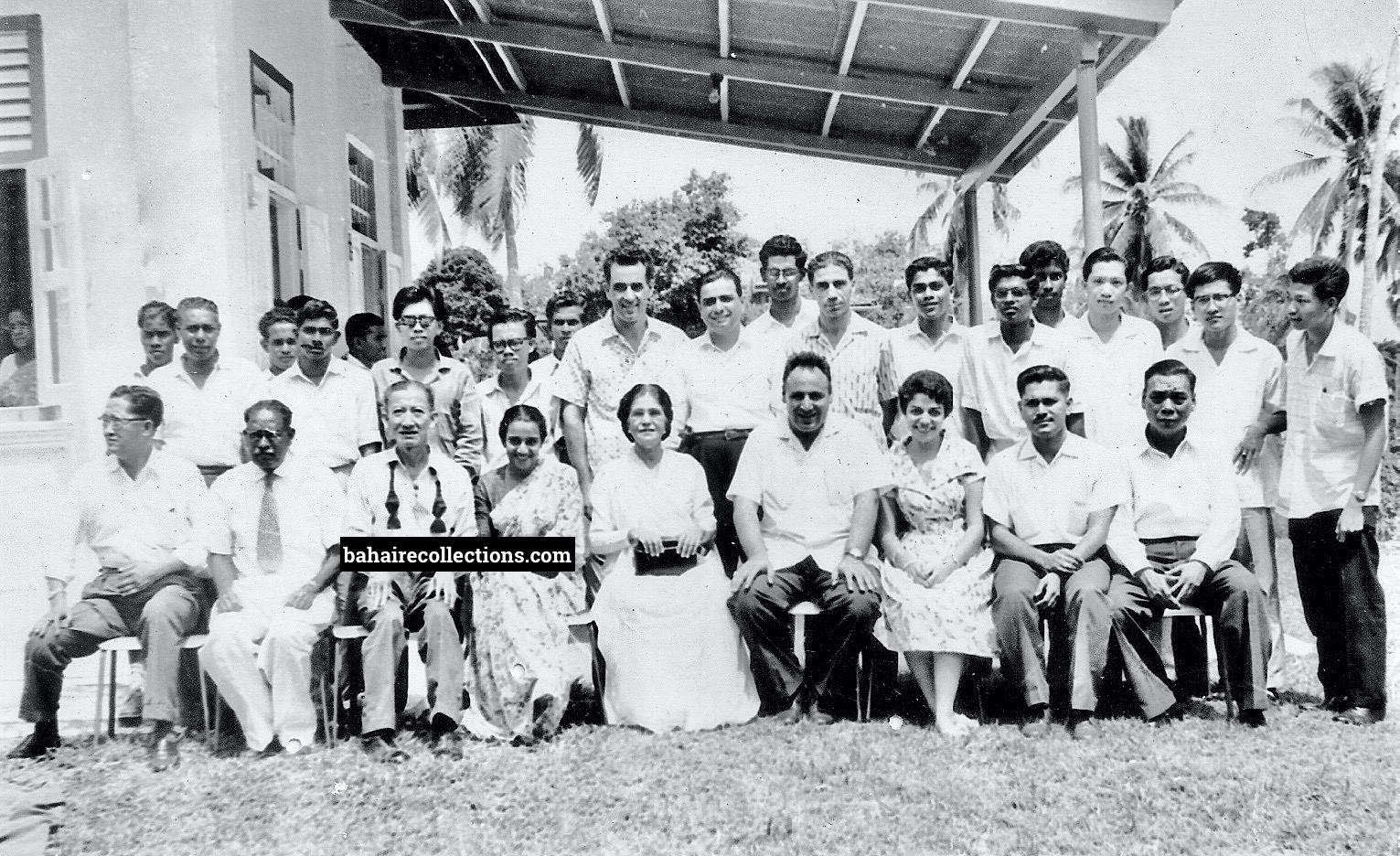
Summer School at Port Dickson, 1960. Seated L-R: Leong Tat Chee, K. Rajah, Yankee Leong, Shantha Sundram, Shirin Fozdar, Dr. Muhájir, Írán Muhájir, Jamshed Fozdar, Wong Kok Mee. Standing second from left is S. L. Thevar. Standing L-R: at the back of Shirin are Payman, Kishen Khemani, S. Bhaskaran, Eshraghian, and S. Satanam
Rajah played an important role as chairperson of a gathering held to honor the first public talk delivered by Hand of the Cause of God Mr. Collis Featherstone when he first came to Malaya. When Mr. Featherstone first came to Malaya in early 1960, there was an air of excitement and the organizing committee made every effort to make full use of his visit. On the evening of 5 October 1960, a Public Talk was arranged at the Kuala Lumpur Town Hall where Mr. Featherstone spoke on the topic of “Pattern for Tomorrow.” More than 60 people attended the talk, which was presided by Rajah.

At the Bahá’í Centre at 106, Birch Road in 1960. Mrs. Shirin Fozdar who has just returned from a world tour addresses the friends. Rajah is seated second from left. This was the Bahá’í Centre that was rented for weekly firesides and public gatherings. The Bahá’í Centre signboard is above the bookshelf, partly hidden.
Back in his home town of Seremban, the years 1960 and 1961 witnessed the coming into the Faith of some great souls. Following the acceptance of the Faith by S. Satanam, some ten of his classmates at the Anglo Chinese School accepted the Faith, including A. Sabapathy. Other youths who accepted the Faith around the same time were Jack Tan, Isaac DCruz, Pauline Yan, Nit Singam, K. Krishnan, and Annamalai. With a group of 16 vibrant youths, the Seremban Bahá’í Youth Section was formed in 1960, with S. Satanam as Chairman. Lily Ng too had accepted the Faith by this time. With this dynamic set of souls entering the Bahá’í fold, the community experienced a hive of activities as never before. Yankee Leong and Rajah were very proud of this development. The Local Spiritual Assembly of Seremban of 1961 took a different turn with membership by new blood with Rajah and Yankee Leong still serving with them. The new members on the Spiritual Assembly of 1961 were Poi Eng Siew, Lily Ng, Stevan, Nit Singam, S. Satanam, Annamalai, and R. Marriappan.
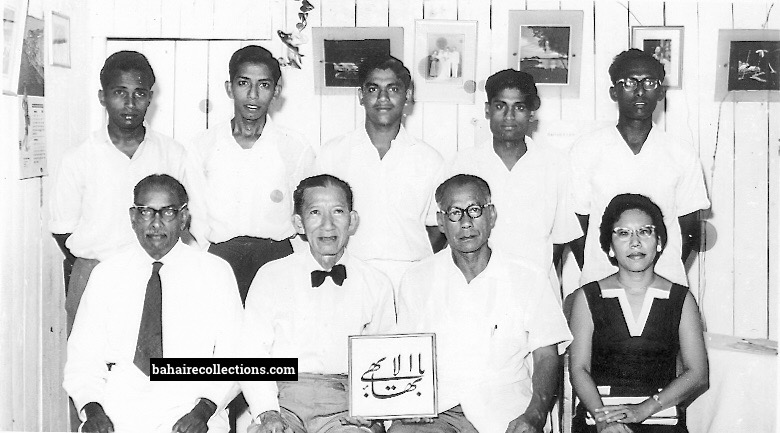
Local Spiritual Assembly of Seremban, 1962. Seated L-R: K. Rajah, Yankee Leong, Poh Eng Siew, Lily Ng. Standing L-R: Stevan, Nit Singam, S. Satanam, Annamalai, and R. Marriappan.
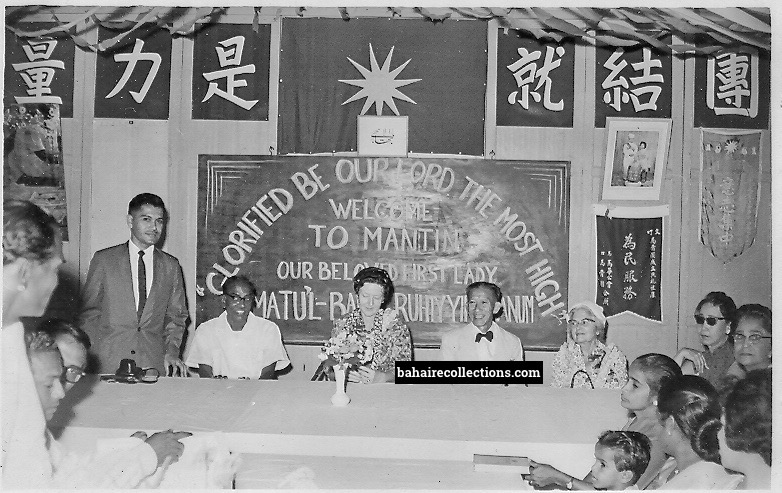
Amatu’l-Bahá Rúhíyyih Khánum meets friends at the Malayan Chinese Association Hall in Mantin, Negeri Sembilan, 1 September 1961 on her first visit to Malaya. From L-R: Jamshed Fozdar, K. Rajah, Amatu’l-Bahá, Yankee Leong, Miss Jessie Revell (Treasurer of the International Bahá’í Council), Mrs. George Lee, Mrs. Shirin Fozdar.
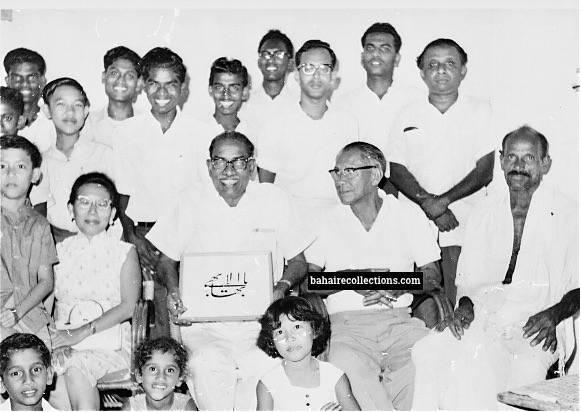
At a Nineteen Day Feast in Seremban in 1962. Seated L-R: Lily Ng, K. Rajah, Poh Eng Siew (unknown). Standing L-R: Krishnan Kandasamy, Annamalai, Vishnupatham. Standing in the center are R. Mariappan (L) and K. Krishnan (R).
Rajah not only served in Seremban but extended his assistance to other communities in the state of Negeri Sembilan. When the Bahá’ís of Seremban took an active role from 1960 onwards in the formation of a Local Spiritual Assembly in Port Dickson, Rajah travelled to deepen the friends there on Mondays, Wednesdays, and Fridays. In 1962 there were 32 believers in Port Dickson and an Assembly was formed. In the mid-1960s he was also assisting the Kuala Pilah community which saw a large number of people accepting the Cause.
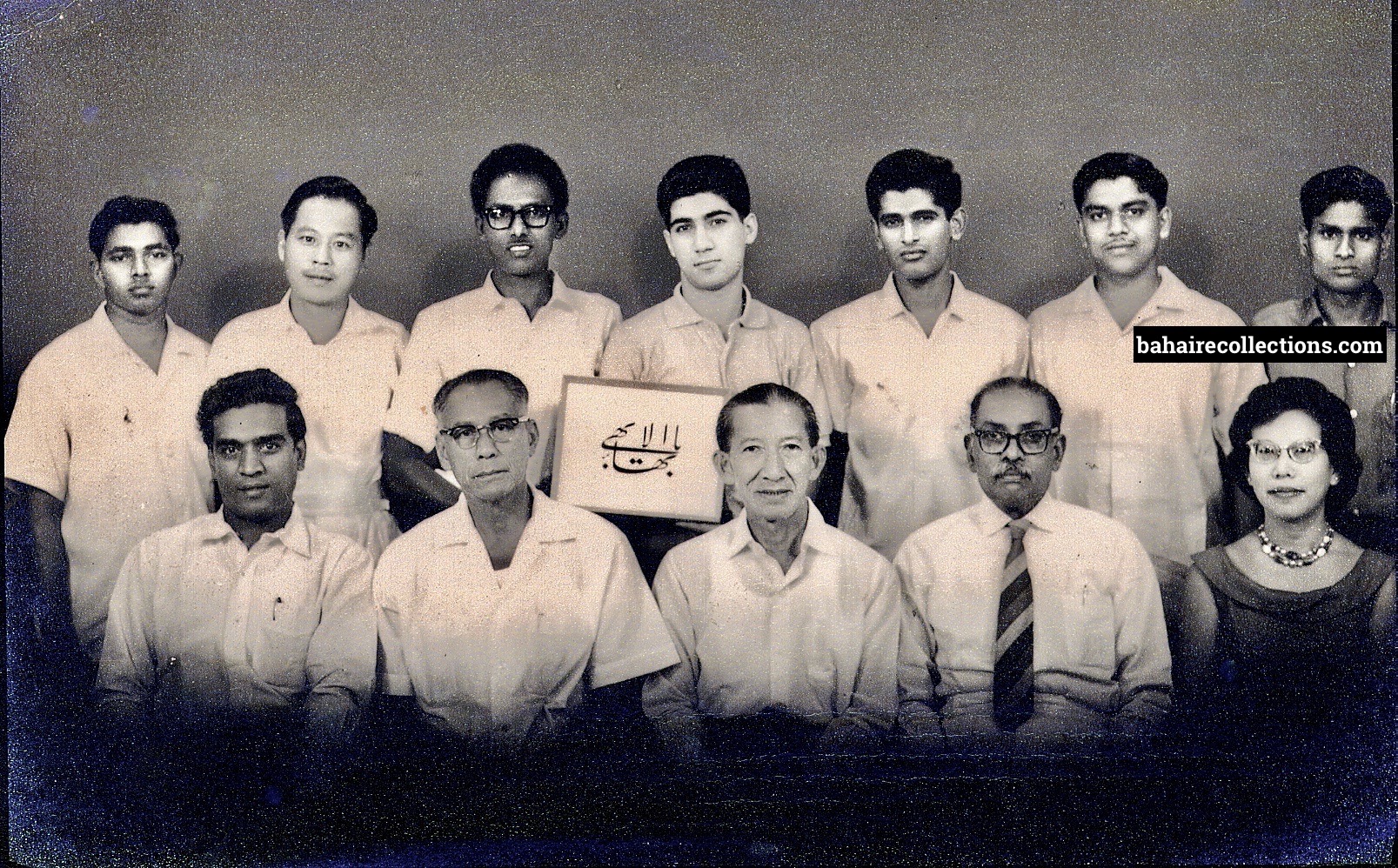 Group photo, January 1963 . Seated L-R: (Unknown) Poh Eng Siew, Yankee Leong, K. Rajah, Lily Ng. Standing L-R: A. Sabapathy, Lee Teck Seng, R. Mariappan, Bijan Bayzayee (Persian pioneer to Laos who passed through Malaya), Isaac DCruz, S. Satanam, Annamalai.
Group photo, January 1963 . Seated L-R: (Unknown) Poh Eng Siew, Yankee Leong, K. Rajah, Lily Ng. Standing L-R: A. Sabapathy, Lee Teck Seng, R. Mariappan, Bijan Bayzayee (Persian pioneer to Laos who passed through Malaya), Isaac DCruz, S. Satanam, Annamalai.

Local Spiritual Assembly of 1965. Seated L-R: Pauline DCruz, Poh Eng Siew, K. Rajah. Lily Ng. Standing L-R: R. Mariappan, Isaac DCruz, Vishnupatham, Lee Teck Seng, Jack Tan. Yankee Leong was on the National Spiritual Assembly in 1965, and in January 1966 he was appointed Auxiliary Board member for Asia with special reference to Sarawak and Brunei.
On account of his vast knowledge and experience in the Cause and life experience, Rajah was also tasked with some pivotal responsibilities. At the Bahá’í Summer School held in Port Dickson in 1960, Dr. Muhájir suggested the appointment of state representatives to open virgin areas in the country to the Faith. Yankee Leong and Rajah were appointed to cover the Seremban areas. In 1963 Rajah was appointed to the National Teaching Committee. In 1965 he was elected to the National Spiritual Assembly of Malaysia at the age of 67 and served on this institution until he left in 1974 at age 76. To date, Rajah has been the oldest member of the national institution at the time of his first election and his retirement.
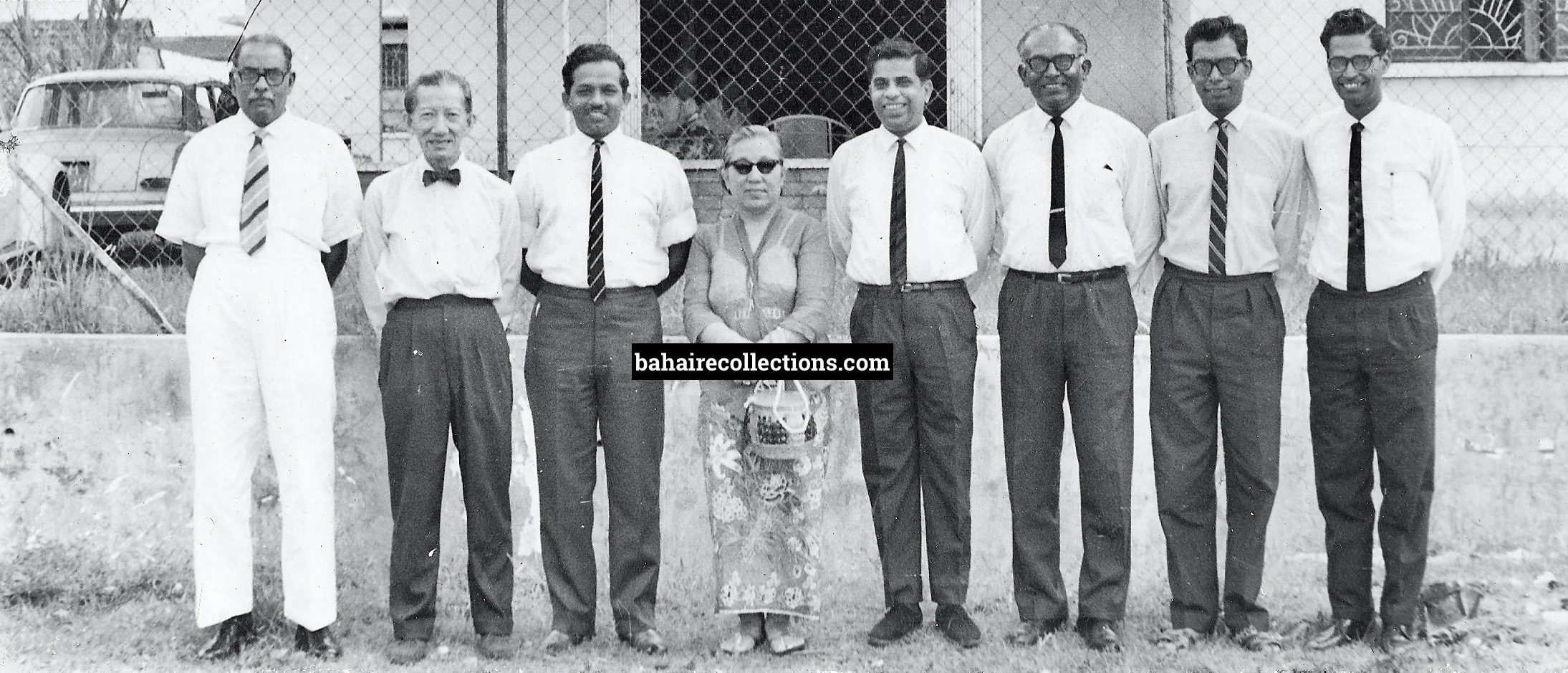
National Spiritual Assembly members of 1965, after holding their first meeting in the newly occupied National Bahá’í Centre at 32, Jalan Angsana,Kuala Lumpur, donated by Mrs. George Lee of Singapore. Standing L-R: K. Rajah, Yankee Leong, Tony Fernandez, Mrs. George Lee, Dr. Chellie Sundram, Appu Raman, Inbum Chinniah, S. Vasudevan. (Missing in the photo is Dr. John Fozdar).
Rajah was said to have contributed much to the deliberations of the national institution. Even while serving on the National Spiritual Assembly he was appointed to the editorial board of the Malaysian Bahá’í News Magazine in 1965, the Temple Site Committee and the Proclamation Committee in 1966, and the National Asli Teaching Committee in 1971. In all these committees he served with distinction.

Bahá’í Seminar in Singapore, December 1966. Seated L-R: Professor Nguyen Van Loi from Vietnam, Hand of the Cause of God Taráz’u’lláh Samandarí and K. Rajah. Standing L-R: M. Maniam, A. Sabapathy, Jami Subramaniam (unknown) G. Appala Naidu, Dr. Mehdi Samandarí (son of Mr. Samandarí) C. Subramaniam, Leong Tat Chee.
By 1966 Rajah was already like the rock of Gibraltar in the Faith and with his significant life experience combined with knowledge of the Faith, he would advise the next generation of believers. At the National Bahá’í Convention of 1966, he told the Bahá’ís to cut away from unwanted old traditions, if these traditions were found to be a hurdle to the service in the Cause. He used to say, “Once you are a Bahá’í you have to stop going to temple, not because we do not respect the temples, but others would not take the Bahá’í Faith and the Bahá’ís seriously.”
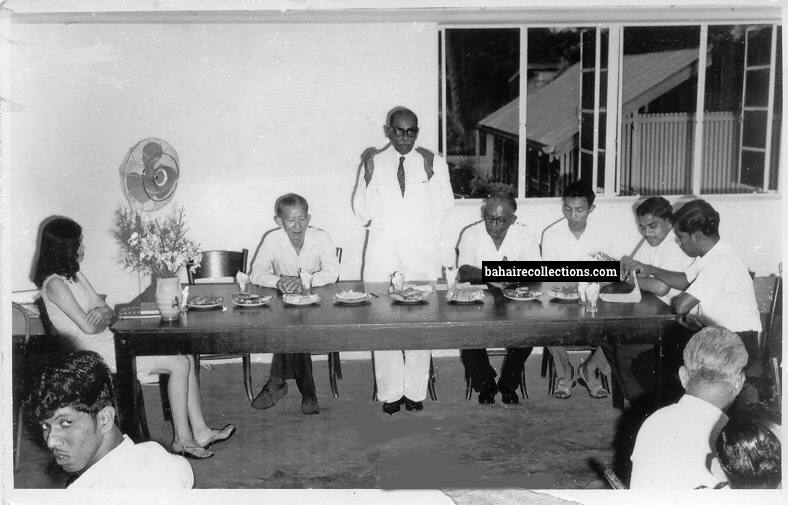
A gathering in an estate, 1967. From R-L: M. Maniam, S. Satanam, Choo Yeok Boon, Appu Raman, K. Rajah, Yankee Leong.
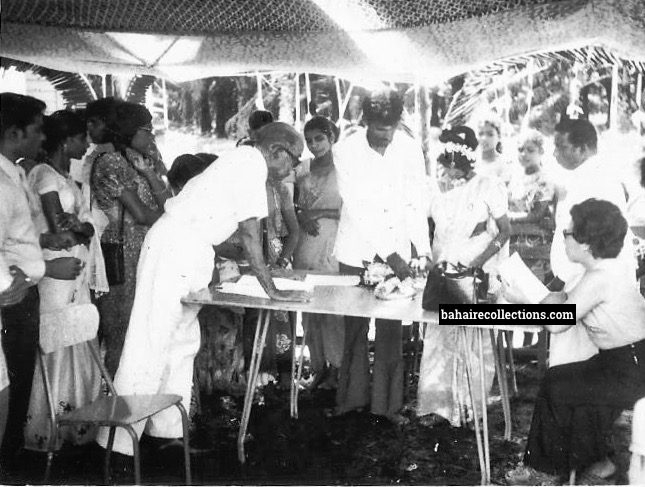
Rajah conducts the Bahá’í wedding of Mr. Jeffrey Bala in Ampar Tenang Estate, near Dengkil town. Seated at the extreme right is Lily Ng.
He would advise the youths. “This is the day of teaching to others what our Faith stands for by our deeds, not mere words. Deeds attract faster than words. Bahá’ís should certainly avoid alcohol. Smoking may be said to be discouraged in the Writings, but if you go deeper into the various passages you know what to do in so far as smoking is concerned.” On the organizing of financial means, he would advise, “After contributing to the Bahá’í fund, make it a point to save at least 10 percent of your earnings for your rainy days.” He also taught some eye exercises to those wearing glasses to keep the vision intact.
Rajah was not so much a field teacher, but he did not miss out on any opportunity to teach the Faith, including to his taxi drivers. When the taxi on which he traveled had already reached the destination, it was common to find that Rajah would stay in his seat for another ten or fifteen minutes, trying to conclude the conversation on the Faith he would have started during the journey. Whenever he arrived at the National Centre, such scenes would thrill the workers at the National Centre. They would whisper among themselves, “Rajah is back in his usual action!”
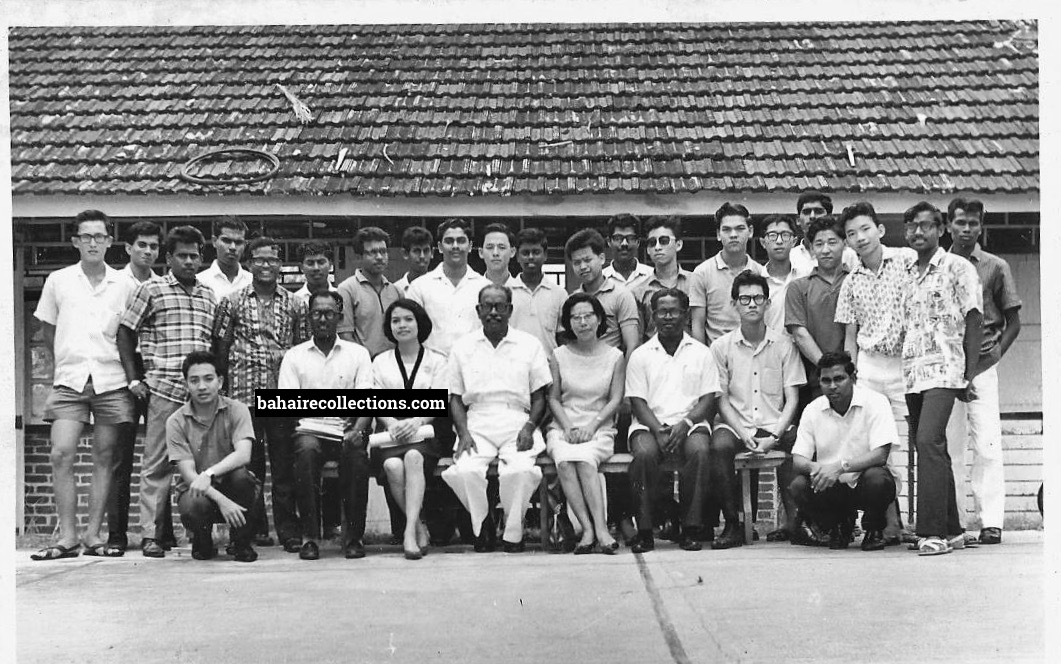
Gathering at the Sports Club of the Public Works Department of Kuala Pilah, February 1966. Seated L-R: R. Mariappan, Mary Tan, K. Rajah, Lily Ng, Stephen Manoharan, Alan Chai. Squatting at left is Jack Tan and at right is A. Sabapathy. At the back of Rajah in white is S. Satanam.
One of the areas that not many ventured into was giving the message to prominent national and international leaders. Here, Rajah played a significant role as he had experience in dealing with people of capacity. He would openly and courageously write to people of prominence both at home and abroad and introduce the Faith to them. At Bahá’í gatherings where he was asked to go on stage and give an update on who were the latest world leaders to whom he had written regarding the faith, he would share the list of names and people he had contacted. These included Prime Minister Winston Churchill of the United Kingdom, Prime Minister Indira Gandhi of India, and many leading officials, people of prominence, and organizations In that sense, he was one of the early initiators of external affairs activities in Malaysia. Noticing his audacity in bringing the Cause to those unimaginable heights, some friends urged Rajah to go slow as they were worried of possible opposition his letters may invite. Yet Rajah was as unrestrained as the wind where service was concerned, little fearing any opposition.
Rajah accepted the Faith at an older age, and driving was not easy for him. He usually traveled by bus for long distances and took taxis for shorter distances. When serving as Treasurer on the National Assembly, Inbum Chinniah, the Secretary would telephone Rajah and send contributions and letters to him through one of the staff of the National Bahá’í Centre, usually C. Kanagaratnam the Administrative Assistant who would travel by bus and deliver them in his home at 70 Hose Road in Seremban. Upon the arrival of the staff in his bungalow, Rajah would be ready with the signed checks and other replies. Rajah had an old Volkswagen car which he seldom used owing to his advanced age and it was other members of the National Spiritual Assembly who provided transport to attend meetings of the national institution, participation in National Conventions and Summer Schools, and other gatherings held in Port Dickson, some 18 miles away from Seremban town. Whenever he went to Kuala Lumpur for meetings of the national institution he would stay in the homes of Inbum Chinniah or Mrs. Gibson when they were on the national institution. Miss Kamachee, a Malaysia’s pioneer to Africa who stayed with the Gibsons observed that Rajah used to wake up very early at dawn to recite the Long Obligatory Prayer.
He was a well-sought after speaker at early Bahá’í conferences and Holy Days gatherings in Seremban and neighboring communities, and his talks were well-researched, informative, and charged. Among the memorable talks he gave were: The overall view of the Bahá’í Faith delivered at the Summer school in 1960; How the Bahá’í Faith can solve the world’s problems at the State Teaching Conference was held in Seremban in November 1963; an introduction to the Faith at the Naw-Rúz celebrations held on a grand scale in Kuala Pilah town in 1966; on Bahá’u’lláh at the Vivekananda Hall at Seremban on His Birth Anniversary 12 November 1967; “Obligations of a Bahá’í” at the Youth Convention for the Central Region was held in September 1970 in Kuala Lumpur. He felt no generation gap with the youth who would flock to listen to his talks. It was such fun to listen to Rajah giving advice in his Ceylonese Tamil to the Tamil speaking believers.
Rajah’s presence at gatherings was always visibly felt as he would always appear in full white attire, often with a necktie. He was a product of British Malaya where the employees used to be attired in white. And Rajah carried this tradition right to his last days. Rajah also proved to be youthful at times. At the Summer School of August 1971 held in Port Dickson, the spirit was so high that the conservative Rajah burst out singing the “I Love You” song – at the advanced age of 73, winning applause from all.
In Ridván 1972, the National Spiritual Assembly of East Malaysia and Brunei was formed. The occasion was graced by the presence of the Hand of the Cause of God Jalal Khazeh from the Holy Land. Also present was Counselor Dr. Chellie. J. Sundram, while S. Nagaratnam and Rajah represented the National Spiritual Assembly of West Malaysia. Rajah also represented the Local Spiritual Assembly of Seremban at the official opening of the new mosque in Seremban in 1967 as he was highly regarded in the government circles. In that sense, he was one of the early initiators of external affairs activities in Seremban.
Rajah was one of those pioneers in producing local Bahá’í literature at a time when there were few reading materials available. In 1967 he came out with a book entitled “God is the All-Knowing Power of the Universe.” He also wrote a book called “Creative Power Behind All Existence” When Hand of the Cause of God God Abu’l-Qásim Faizi came to Malaysia for a conference in 1968 he read this book and commented, “Rajah now writes with full conviction what he had been speaking of before.” In 1975, Rajah again wrote a book called “Poverty to Plenty” with an introduction by the famous Bahá’í writer Stanwood Cobb. The other books by Rajah were “Know Why You Are Living On This Earth,” “Work For All, A Challenge To Our Society” and “Conflicts In Values, Peace or War.” Thus, in his own small way, Rajah had contributed to enriching the Bahá’í literature in the early days.
He was on the National Spiritual Assembly from 1965 (Vice-Chairman), and its Treasurer from 1967 to 1972. In 1973, N. Sivasathiaseelan Nadarajah (N. S. S. Silan) became the National Treasurer to whom Rajah passed on the handover notes and other documents. After going through the well-kept records that Rajah had produced, Silan remarked that the financial ledgers were well maintained and that Rajah had indeed set a high standard of financial records maintenance with all supporting vouchers and documents. Rajah was last on the National Spiritual Assembly for the term 1973 to 1974.

National Spiritual Assembly of 1973. Seated L-R: Yin Hong Shuen, Ganasa Murthi, Shantha Sundram. Standing L-R: A. P. Arumugam, K. Rajah, S. Nagaratnam, Dr. M. M. Sreenivasan, Isaac DCruz, Dr. M. Singaraveloo.
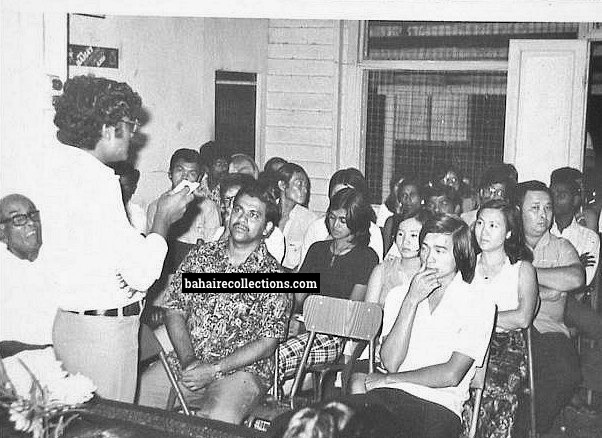
Rajah at the left listening to a talk by the author at the Seremban Bahá’í Centre, 1976. In the center is S. Satanam and at the extreme left is Giam Chin Chye. Seated in the back row with folded arms is Mr. Lee Swee Leong while Sobhana Kumaran in the black outfit.
Following his advanced age and ill health, Rajah could no longer attend Bahá’í meetings. But he would with difficulty visit the Seremban Bahá’í Centre as his heart was always with the Bahá’í Centre. He was always hungry for news of Bahá’í activities. Satanam made it his duty to visit Rajah often in his house to keep him informed of the growth of the Faith and bring him to the Bahá’í Centre. In the later part of the 1970s he slowed down further, and his daughter Thavamany and relatives would drop him at the Bahá’í Centre and transport him back after the meetings were over. Some Bahá’ís too would provide transport for him to come to some events held in Port Dickson. He entered the Faith at the age of 56 and had done his utmost within his strength until he was no longer able to serve actively.
Although Rajah did give the Faith to all his family members, it was only his son Vijayasingam who accepted the Faith in 1970 when he went over to Christchurch in New Zealand to take up university studies. He was actively involved in teaching activities in the local community. Towards the evening of his life, Rajah had been talking to S. Satanam of his desire to donate a portion of his property to the Cause, but that did not materialize as he had slipped into ill health to proceed on that arrangement.
After a prolonged period of illness for many years, he finally passed away on Sunday, 20 December 1992 at the age of 94 in Seremban and was given a befitting Bahá’í burial at the Seremban Bahá’í burial ground. S. Satanam ensured that all arrangements for the funeral went well. After listening to glowing tributes paid by the Bahá’ís, Mr. Kulasingam, the eldest son of Rajah, broke into tears and thanked the community for the love and affection shown him. His parting words were, “I never knew my father had done so much for the Bahá’í Faith and had touched so many hearts. Today I feel prouder than I ever before to be his son.”
Thus, ended the life of a person who accepted the Faith at an advanced age and served the Faith in various capacities with amazing zeal, driving force, and distinction. His life became an excellent example of how age is no barrier to serving the Cause. In hindsight one would conclude that Rajah was chosen for the pivotal roles he performed with distinction and thus won for himself the crown of distinguished service to the Malaysian Bahá’í Community. No keen and honest observer of history can truthfully ignore that an ordinary man, Rajah Kathirvelu, has become a truly legendary figure in the annals of our Faith.
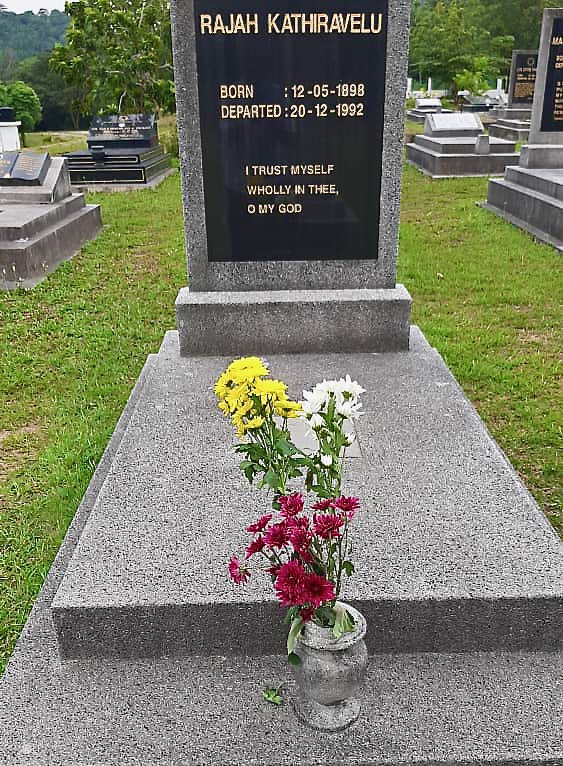
A truly legendary figure in the annals of our Faith.
A. Manisegaran
31 December 2020
copyright@bahairecollections.com
19 thoughts on “REMEMBERING K. RAJAH”
Mr. K. Rajah deserves all the praises in every way. It is good this story has come out at a time when not many of the current generation may still remember the heroes of the bygone era.
Mr. Rajah who was residing at Hose Road, Seremban was an exemplary believer in the Cause of Bahaullah. In the early days inn 1960s. he was an active member of the Theosophical Society in Seremban together with Yankee Leong. When Yankee became a Baha’i he also came to know about it and accepted the Faith soon after. He became very active in his new-found Faith and never miss out on any Baha’i activities. Thereafter Mr. Poh Eng Siew also became a believer and came to the forefront of the activities. This also the time when Mr. Satanam, Isaac DCruz, Sabapathy and a band of youths including myself began to teach the Cause of God.
Mr. Rajah being a Ceylonese Tamil, was very well known among the rich and well to do Ceylonese and Hindu communities of Seremban. He was so touched by the greatness of the Faith that he began to openly proclaim the Faith everywhere he went. He told the youths that he had nothing better to do. He spoke to all his friends and relatives about Bahaullah everyday so much so his Hindu friends began to wonder what made this devout Hindu become a preacher and champion his new-found Faith.
As he was verbally delivering the Message he found it inadequate to complete this task. So, he printed thousands of pamphlets both in English and Tamil and distributed them far and wide. He also joined the youths to travel to the various estates in Negeri Sembilan. For this purpose, he promptly gave his car for the purpose of teaching.
In the estates he sat with us and spoke to the enquirers on the importance to know the Messenger of God for today. He also told them to diligently carry out their duties in the spirit of “Work is worship; service is prayer.” He also advised them not to neglect their work and take off too many days off from work, as this will affect their livelihood and the vital duties to the family. There was a time when he became obsessed with the idea of ikan billis (anchovies). He began encouraged all the Bahais to eat this fish as a cheap source of protein.
On a few occasions when Feasts were held in his house, invariably the fiends were served with varieties of dishes of this fish that he promoted.
When Yankee began to travel abroad to teach the Faith he took upon himself to shoulder all the responsibilities of Baha’i activities in Seremban. He also took part in the various national activities throughout Malaysia.
He also printed some booklets on the Faith in order to propagate the Faith. He was a great teacher of the Cause right up to the last of his breath.
May God bless this wonderful servant of God.
Krishnan Kandasamy
Muar
Malaysia
You have done it again Manisegaran!
What a wonderful story of remembering the life of Mr. Rayjah, a man who lived in two millenniums and nearly three different centuries… especially during the time of his life and the events that were unfolding. His sacrifices of resigning from his important roles of the organizations and the rewards of being in the audience of so many Hands of the Cause of God, the 1958 Singapore Conference and the first Baha’í World Congress in London… all are very inspiring. May God advance his soul through the worlds of God.
Lee Lewis,
Hawai’i
Dear Manisegaran
I read the entire story in one sitting. That was a perfect portrayal of a great servant of God. I took pictures with him when I visited him in those days. He was a no nonsense person and yet an embodiment of love for mankind.
Professor Ananthan Krishnan
Puchong
Malaysia
I read this story. It was very inspiring to reconnect with a great worker of the Cause of the earlier generation.
He may have ascended to the next kingdom, and yet I shall call “A Living Legend”. I never met him before personally. I only heard his roaring spirit from my late father Mr. M. Maniam. But your write up took me to near meeting him kind of experience, with so much live in the story.
May God grant them blessings in heaven.
Srimathy Maniam
Sarawak
Malaysia
Brother Manisegaran
Thank you so much for taking me back to my “Bahai Roots” so to speak….
I remember Mr Rajah very well. Have been to his place at Hose Road and even won a prize from him for an essay writing competition.
I remember him at the Feasts and I remember him speaking forcefully about service and serving..
I was present at his funeral and remember quite clearly his oldest son being very overwhelmed by the funeral service and the eulogies of his father..
Thank you for this inspiring article and bringing the importance of service to the fore of anyone’s life irrespective of age..
Thank you once again for all the articles you have written…
Rest assured that what you are writing are definitely inspiring someone out there to redefine their goals of life..
Gunendralingam
EAST TIMOR
I read the story on Mr. Rajah Kathiravelu.
Malaysia has produced more than its share of legendary figures. There must be something behind this success stories.
How I wish I could come over and do some research into this phenomena.
Maung Maung
Myanmar
Thank you so much for well written article on a great soul Rajah.
He is blessed by Baha’u’llah for his service to this cause.
He was an example for us to follow.
Thanks for sharing.
Krishna Seegopaul
Guyana
Another wonderful and very inspiring story. Keep it up please.
I was in Malaysia twice, 1958 and 2014. Mr. Rajah’s heroic life and that of Mr. Leong Tat Chee in whose home I stayed in 1958 confirm the impression that Morocco and Malaysia will have an important role among Islamic countries in recognizing Baha’u’llah as the Savior of humanity from our extreme waywardness. Let the Baha’i communities compete for such historic honors. Blessed is Malaysia.
Professor William Maxwell (a Baha’i since 1952)
Arkansas
USA
This is yet one more masterpiece by the Author Manisegaran.
I had heard so much of Mr Rajah when I accepted the Faith in 1980, and had wanted to see him. By that time he had reduced his activities owing to old age and so I missed meeting him.
I am thankful to the author for penning this story which has brought a greater understanding of one who deserves to be remembered and admired for a number of reasons as revealed in the story. His rise was meteoric the moment he accepted the Faith. His commitment and devotion were for his Creator, and he seem to have no fear for the talks of his community in which he was steeply involved. It takes so much audacity to cut off from old ways. He loved the entire human kind more than his own kind.
Uncle Rajah’s services and dedication have left a strong and deep influence and impact in my own heart. Thank you brother Manisegaran for bringing to life one who deserves to be remembered forever.
May his soul continue to be blessed in the next world
Nehru Arunasalam
Chicago
USA
That was an inspiring write up on Mr. Rajah. I am happy you have written on him. I honestly did not expect you to write, and having written you have gone into so much detail on his life and legacy. I must admit that I did not know some of the details you had given.
We called him “MR WHITE”-always appearing in white, with a prayer book in his shirt pocket. He was a father like figure in Seremban, with so many youths flocking around him. His target was mainly youths and he always spoke to them of living a chaste and holy life. His talks always ended up with a statement that we must always follow the road, i.e. the straight path in the Writings
I love to listen to his talks at firesides and public talks. Rajah’s knowledge of the Faith was certainly very deep, wide and vast, given that he was an avid reader. He was one who was always on the lookout for enquirers to teach the Cause. He was a fearless roaring lion when defending the Cause. His skills in putting forth arguments in defense of the Faith was marvelous. We had a mutual liking. Each time I went to Seremban he used to welcome me with so much happiness.He always had something to say to cheer my heart, and mostly quoting from the Writings. We sadly miss such caliber of rare Bahais these days. They had lived in the past, and remain alive only in our history.
Thank you Manisegaran for writing about this immortal soul, who has immortalized the history, the Cause and the community with his legendary services, quite unparalleled in many ways
Anthony Casimir Louis
Malacca
I had the bounty of meeting Mr. K. Rajah more that ten times over many years during the sixties, seventies and the eighties at Summer Schools and at the National Spiritual Assembly meetings in Malaysia. The Universal House of Justice was overjoyed with the development of the Faith in Malaysia. And K Rajah too had his share in contributing to the development of the Cause, as an able national treasurer.
One could see K. Rajah stood up as one of the stars that tirelessly committed his life to the progress of the Faith. His life story shows that Rajah that was already looking for the Message even before he had enrolled into the Faith in 1954. The rest is history as seen that he was intimate with the growth of the Faith in Malaysia from its inception was packed with forty years of many untold stories, some of which have appeared today, for the first time, in this story written by Manisegaran.
Once in the seventies when I was a Counselor, I had the bounty of traveling with him and a few members of the National Spiritual Assembly from Kuala Lumpur on a consolidation visit to the Baha’i communities of Ipoh, Penang, Sungei Petani and Alor Setar. Several times I shared the same room with Rajah and on my request he relate the stories of the development of the Faith in Malaysia. I realized he was a keen observer of the development of the Cause in that blessed country
Dr. Firaydun
Chieng Mai
Thailand
God bless his radiant soul.
Regards,
Firaydun
I read the life history of Uncle K. Rajah, a prominent and enlightened soul. That was truly very interesting and was an inspiration to me. That he was able to serve so effectively at an advanced age was very touching.
I spent my higher school days in Seremban when I was not a believer yet. I accepted the Faith through Mr. G. Appala Naidu in 1966 when I was in Bahau, and came back to settle in Seremban in 1982. By that time Uncle Rajah was not actively coming to the center as he was very old and feeble. But old believers like Satanam used to speak the greatness of Uncle Rajah. On a number of times Satanam took me along to visit Uncle Rajah at his home at 70 Hose Road. Although he was weak physically, his spirit was still as strong as ever.
When he passed away, Satanam played an important role in getting a befitting Bahai burial for him. The National Spiritual Assembly of Malaysia had tasked me with burial arrangements whenever a believer had to be buried at the old Seremban Bahai cemetery. And I was there to see to his burial arrangements. He may be buried, but his name,fame and services live forever..
Thank you Manisegaran for painstakingly preserving for posterity historical records with such accuracy.
Subbarao
Seremban
Malaysia
Dear brother Manisegaran,
This is an inspiring story for all of us.
What an amazing soul Mr. K. Rajah has been! This servant of Baha was elderly, yet age did not the least prevent him from contributing to the Cause and struggling with full devotion, throughout his life. I cannot say much more than such a great and exemplary soul. I am truly lost for words because he was so great in his courage, knowledge and all the pioneering efforts he had undertaken.
He really set an amazing example that not everyone could easily emulate. Seldom had I come across such shining examples in recent years.
Mr. K. Rajah often advised young people to put into actions whatever they had read in the Writings. As a fatherly figure he deserves to be an example to today’s many young people.
When I read this story I felt like Mr. Rajah advising my own self. I will include him in my prayers for his soul to progress in the realms of the Abha Kingdom.
Thank you so much for the story of this amazing soul that history shall never neglect of forget
Greetings
Chosin Abdullah
Jakarta
INDONESIA
I have had the privilege of meeting Mr.K.Rajah at many gatherings since 1965. In 1969, the National Spiritual Assembly of Malaysia loaned me the money to pay for my airfares to attend a Bahai Youth Conference in Manila, Philippines. Mr.Rajah was the NSA treasurer and the manner with which he conducted the transaction was indeed praiseworthy.
Subsequently, in 1972, I was the incoming NSA Treasurer and had to take over the records from Mr.K.Rajah, the outgoing Treasurer. From him I learned the necessary requirements of maintaining the records of a National Spiritual Assembly. Every cent received and paid was accounted and supported with necessary documentation. We were both in the NSA for a few months until I left for Africa in September 1972 with five others, on the appeal by Hand of the Cause Dr Muhajir to assist the African friends in winning the remaining goals of the Nine-Year Plan.
I remember Mr.Rajah was responsible for the purchase of the Temple Site Land in Cheras area, near Kuala Lumpur. He, with other members of the Task Force conducted the transaction in the best interest of the Faith and getting good value for the trusted contributions.
Persons of such integrity and values contribute to the standards as required in managing the affairs of the Faith. He left an everlasting impression which became a source of reference for me, as we continue to serve the Faith.
Thanks for the write up of his legacy.
Silan Nadarajah
Sydney
Australia.
Dear Manisegaran,
What a lovely story of one whom I always loved and admired. The last time I met the highly regarded, elderly and steadfast believer, Mr. K. Rajah of Seremban, was over fifty-three years ago. Time has not effaced the memory of those early days of my life when I embraced the Cause. The first and greatly loved believer of the country, Yankee Leong set Rajah’s heart on fire when he taught him the Faith in 1953. Deeply moved, Rajah studied any material he could get on his new found faith and withdrew from his other public service commitments in order to serve the Cause.
Rajah was a product of the glorious period of the Ten-Year Crusade and belongs to a group of elderly, revered and eminent servants of the Cause in Malaya and Singapore: Uncle Yankee, the Spiritual Father of Malaysian Baha’is; Leong Tat Chee, the indefatigable promoter of the Cause; Wong Kok Mee, the devoted laborer in His Vineyard; and Mrs. George Lee, the devoted and gracious philanthropist. These are among the early pillars from whom the other and younger equally committed Malayans received guidance and never-to-be-forgotten love.
Immaculately and simply dressed in white, he was punctual and regular at all important Baha’i meetings. We were youths then, energetic and eager believers, and he was the benign venerable elder whose words of wisdom were gratefully accepted. In the early days of Seremban Uncle Yankee Leong, Mr. Rajah and Mr. Poh Eng Siew were the three patriarchal figures around whom flourished a devoted group of friends, mostly youth, who gathered almost daily at the Bahai Centre which was Uncle Yankee’s home. Mr. Rajah had just retired as the State Treasurer of Negeri Sembilan when he whole-heartedly accepted the Faith and became an ardent supporter and champion of the Faith. By 1960 he gave up his highly regarded positions of responsibility to concentrate on solely pursuing the teaching work and undertaking travels to lecture at meetings or deepen the friends.
When I accepted the Faith in 1960 I became aware that his transformation from being a dignitary in the Jaffna-Ceylonese society to an ardent devotee of the Cause had evoked considerable opposition in his community and not without reason : he had been a recognized leader, and had been the State Treasurer of Negri Sembilan, the Chairman of the Theosophical Society, and the Director of the Consumer Society of Malaya besides holding the post of Treasurer in the Social Welfare Society of Malaya. He faced their resentment and opposition heroically, with absolute detachment and steadfastness.
We were youths then and Mr. Rajah was wont to act as friend, guide and philosopher to us. In his talks he spoke of the need to avoid easy familiarity between youth of both sexes and the dictates of propriety. He was a member of the National Teaching Committee and often met with Uncle Yankee, Leong Tat Chee, Inbum Chinniah, Maheshwar Dayal and Dr. Robert J. Wolf. It was this group that prepared the way for he first National Convention in 1964. He traveled from Seremban to Malacca, Kuala Lumpur, Kuala Pilah, Singapore and many other places to speak in both English and Tamil. He also visited rubber plantations and taught among the laborers. In 1961 the Hand of the Cause Dr Muhajir and some members of the Regional Spiritual Assembly of South East Asia, including Mrs. Shrin Fozdar attended a teaching conference at the Indian Association Hall in Seremban The Hand sent small groups of believers into the rubber plantations and demonstrated the direct method of teaching among the masses. This set the stage for Seremban to become an early center of mass teaching. Mr. Rajah was an inspired teacher who led the way by his example. This was about the same time that Uncle Yankee opened up Asli settlements to the Faith, and later went to Sarawak to bring in the tribal masses into the Cause. It was delightful to hear his Jaffna Tamil, and his use of quaint Tamil words that survived only among the Ceylonese Tamils. Mr. Rajah’s talks included his advice for the laborer community to give up superstitious practices, to avoid alcohol and smoking. All accepted his guidance with great respect and he never came across as puritanical.
A high point of his Bahai life was his participation in the 1963 World Congress at the Royal Albert Hall in London. He was able to glimpse the glory of the Faith at that global gathering of Hands of the Cause and the newly elected Universal House of Justice with over six thousand believers from every background of color, race and persuasion.
A man of scrupulous work habits, he was punctual at meetings, and an immaculate keeper of accounts and of records. His invariable advice as Treasurer of the National Spiritual Assembly was to guard against avoidable expenditure. Even so he could never be regarded as money minded. In 1965 Mr. Rajah was elected to serve on the National Spiritual Assembly of Malaysia. He continued to serve as Treasurer for a considerable period.
Two years ago, when my wife Sitara and I were visiting Kuala Lumpur, we unexpectedly stopped by at the Vivekananda Ashram in Brickfields, a haunt of my school days, some seventy years back. When the Secretary of the Ashram heard that I was a Bahai he talked of Mr. Rajah with deep respect and said that he himself was a regular at his home, and learned the essentials of the Baha’i Faith from him.
Dr. S. Vasudevan
Pune
India
Dear Uncle Mani,
The recollection of Mr. Rajah, “The Man In White” is really a fascinating one. Though he had accepted the Faith at fifty-six, he had truly demonstrated such enthusiasm and devotion for the advancement of the Cause in every possible way. I sincerely dare not challenge that I will have his youthful energy in my old age! My aunt Kamachee Martel said Mr. Rajah was so transparent being a state treasurer. He rejects the term ‘miscellaneous’ over an item of expenditure and insisted to have a detailed account for every single expenditure and not hiding expenditure in the name of miscellaneous! That shows his integrity and professionalism and as a civil servant, his standard was really high. In every aspect of Bahá’í life, I think Mr. Rajah was so fortunate to have gained so much knowledge, inspiration, and great influence from all those Hands of the Cause of God he had met in person. It’s rather difficult to move away from one’s tradition but Mr. Rajah preached that “Man must have the courage to move away from traditions. Only those who have vision accept the Bahá’í Faith.” I see that Mr. Rajahnot only exhibited such power in his principle, but he was a trendsetter to the next generation of believers!
His capability as an early initiator of external affairs activities in Malaysia was beyond belief. From the time he had accepted the Faith, he taught the Faith to those members from all his former organizations and successfully brought them into the Cause, tirelessly served the Faith in every possible capacity appeared to be the source of encouragement to the friends and was always ready to go that extra miles in propagating the healing message of Bahá’u’lláh, an eloquent Bahá’í speaker, passionate reader, and author of several books, highly respected and regarded in the government circles, highly a valued member of the Spiritual Assembly and among all, he was a great servant of the Blessed Beauty and a true friend – cherished by everyone.
The author was so accurate to say that Mr. Rajah was an ordinary man who had become a truly legendary figure in our history. This is yet another profound recollection by the author. May his radiant soul reap all the goodness and bounties and continue to enjoy the company of numerous other stalwarts in the external realm.
With Loving Bahá’í Greetings,
Vela Gopal
Phnom Penh, Cambodia
Mani,
I had the privilege and honor of meeting Uncle Rajah in 1969 and 1970, when he came for the National Assembly meetings at the National Bahai Center at 32 Jalan Angsana, Setapak, Kuala Lumpur. I remember how the other members of the National Assembly treated him with great fondness and love. During their break from their meetings, there was always much laughter. He was always telling jokes and lightening up everyone after the long sessions. When Uncle Rajah laugh’s it is a soul-elevator, it takes the entire group into further laughter. Standing by to serve the Assembly members with packed lunches, I was always amazed to see Uncle Rajah as the first one to start a joke and the series of jokes would pour from him throughout their lunch break. Looking back, I am missing this simple and yet great soul more than ever.
C. Kanagaratnam
Scottsdale
Arizona
USA
Dear Manisegaran,
How can we ever thank you enough for bringing such giants and heroes to our memories. Rajah was a very humble person. After I was appointed Counsellor, he would always send his articles to me for approval till I told him that he was doing a fantastic job and I was not a censor and he should stop treating me as one. There was no element of ego or arrogance in him. A very rare jewel. You have bought out the shine in him. We are very grateful.
Dr. John Fozdar
Kuching
Sarawak
Malaysia
Mani
I read every detail of your story on Uncle Rajah. I moved closely with him while I was in Seremban, though I had known him since I became a believer in 1963.
Mr. Rajah had several qualities that need to be mentioned. He was a very firm believer in Bahaullah and the Cause He brought. His love for the Faith was unshakable and unquestionable. He never compromised on the principles of the Faith. He was very courageous in promoting the Cause. There was no element of fear in him and he withstood the strong opposition from the Tamil Ceylonese community he came from. These are already mentioned by you. I am repeating just to say that you have captured his life and legacy very accurately.
At conferences he was a centre of attraction, not only because he was attired in pure white, but also because of the talks he gave. And his target was always the youths to whom he used to give advice to lead a chaste and holy life. I can never forget his jokes and his remarks in the typical Ceylonese Tamil slang.
You have written about this hero of the bygone age. And we seldom come across such angelic souls these days. I guess different seasons bring forth different kinds of workers for the Cause.
N. Nagendran
Kuala Lumpur